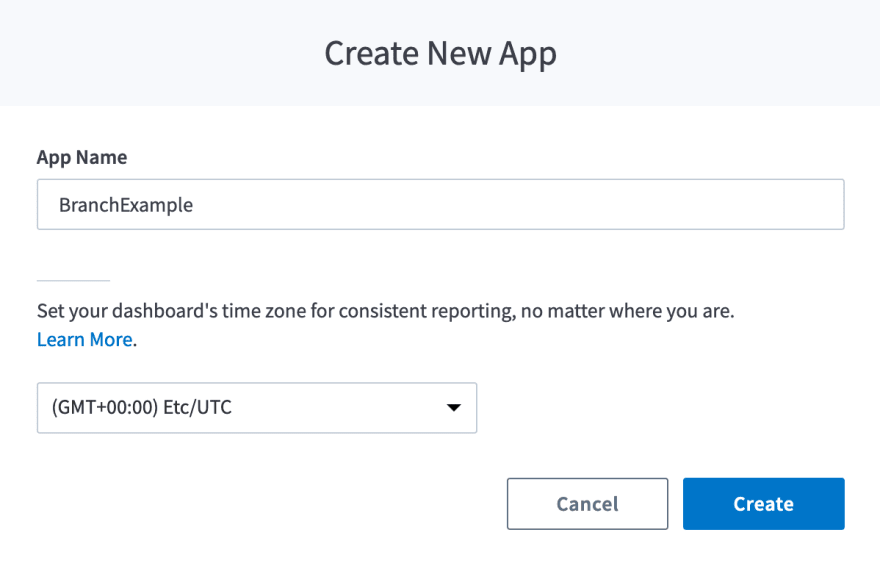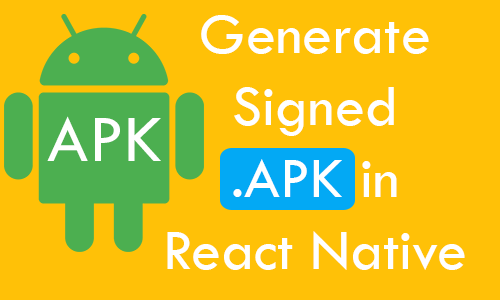React Native Generate Signing Key
- React Native Generate Signing Key Is Going
- React Native Generate Signing Key Is Better
- React Native Generate Signing Key Is One
Welcome to the very start of your React Native journey! If you're looking for environment setup instructions, they've moved to their own section. Continue reading for an introduction to the documentation, Native Components, React, and more!
Sep 05, 2017 For new apps, we can generate your app signing key. Once enrolled in app signing, you sign your APK with an upload key, which we use to authenticate your identity. We’ll then strip that.
- May 05, 2019 React Native Get SHA1 MD5 Key Certificate using CMD Android Studio admin May 5, 2019 May 5, 2019 React Native Secure hash algorithm also known as SHA1 certificate is a unique device identifier globally unique to identify each system alone.
- Dec 24, 2017 Step – 1: Generate Signing key through command prompt. Run command prompt with administrator permission: Just change your PWD( Present Working Directory ) to jdk/bin directory through command prompt. Apply the following command in command prompt and hit ENTER.
- In React Native when I'm trying to get Google GPS API key in Google console, I have seen package name and SHA-1 key where to I get SHA-1 key in React Native How to get SHA-1 key in React Native cl. Stack Overflow.
Many different kinds of people use React Native: from advanced iOS developers to React beginners, to people getting started programming for the first time in their career. Django generate secret key bash. These docs were written for all learners, no matter their experience level or background.
How to use these docs
You can start here and read through these docs linearly like a book; or you can read the specific sections you need. Already familiar with React? You can skip that section—or read it for a light refresher.
Prerequisites
To work with React Native, you will need to have an understanding of JavaScript fundamentals. If you’re new to JavaScript or need a refresher, you can dive in or brush up at Mozilla Developer Network.
While we do our best to assume no prior knowledge of React, Android, or iOS development, these are valuable topics of study for the aspiring React Native developer. Where sensible, we have linked to resources and articles that go more in depth.
Interactive examples
This introduction lets you get started immediately in your browser with interactive examples like this one:
The above is a Snack Player. It’s a handy tool created by Expo to embed and run React Native projects and share how they render in platforms like Android and iOS. The code is live and editable, so you can play directly with it in your browser. Go ahead and try changing the 'Try editing me!' text above to 'Hello, world!'
Optionally, if you want to setup a local development environment, you can follow our guide to setting up your environment on your local machine and paste the code examples into your App.js file there. (If you are a web developer, you may already have a local environment set up for mobile browser testing!)
Function Components and Class Components
With React, you can make components using either classes or functions. Originally, class components were the only components that could have state. But since the introduction of React's Hooks API, you can add state and more to function components.
Hooks were introduced in React Native 0.58., and because Hooks are the future-facing way to write your React components, we wrote this introduction using function component examples. Where useful, we also cover class components under a toggle like so:
You can find more examples of class components in previous versions of this documentation.
Developer Notes
People from many different development backgrounds are learning React Native. You may have experience with a range of technologies, from web to Android to iOS and more. We try to write for developers from all backgrounds. Sometimes we provide explanations specific to one platform or another like so:
React Native Generate Signing Key Is Going
Web developers may be familiar with this concept.
Android developers may be familiar with this concept.
iOS developers may be familiar with this concept.
Formatting
Menu paths are written in bold and use carets to navigate submenus. Example: Android Studio > Preferences
Now that you know how this guide works, it's time to get to know the foundation of React Native: Native Components.
-->Signing an app is a requirement to run an app on real devices during the development process or to distribute it via a beta program or in the Play Store. Without code signing, the app can only run on an emulator.
When App Center builds an Android application with a debug build type, a keystore associated with a developer isn't required but can be uploaded. These builds will be automatically code signed with a debug key. For a release build that will be deployed, you have to upload a keystore to App Center.
Generating a keystore
If you don't currently have a keystore, you can generate one in Android Studio. You can find instructions on generating a keystore to sign APKs in Android Studio's official User Guide.
Setting up Code Signing
App Center supports three different ways of setting up code signing for Android apps. For all three methods, you first need to go to the build configuration and enable code signing:
- Go to your app in App Center.
- Go to Build.
- Go to the branch you want to configure by choosing it from the list.
- Either use the 'Settings' menu in the upper-right corner, or choose Configure if your branch is not configured for build yet.
- Enable Sign builds.
- Choose Save.
Then, depending on your scenario, use the most suitable of the three options in the sections below. The first option involves checking in credentials to your repository, while the other two use App Center to handle your credentials instead.
A. Storing everything in the Gradle configuration
You can specify the signing details in the build.gradle file. The signing details, along with all credentials and the keystore information, will be visible in the repository. First, add all the items you need to your code and check them in to your repository. Then in the build configuration in App Center, enable My Gradle settings are entirely set to handle signing automatically.
B. Uploading everything to App Center
You can upload the keystore and configure the signing credentials through App Center. In this case, App Center will first build your Android app and then run a signing step after the successful build.
Note
A build can only be signed once. Make sure you have no conflicts with signing configurations in your Gradle configuration for the chosen build variant. If there are signing settings both in App Center and in the Gradle file, the build may end up signed twice and this will lead to conflicts.
Set up your build configuration in App Center as follows:
- Disable My Gradle settings are entirely set to handle signing automatically.
- Upload your keystore file to the Keystore file upload file drop. You can drag the file onto the box or click it and browse for the file. Keystore files have the extension .keystore or .jks.
- Enter the keystore password, key alias, and key password in the corresponding fields. These values are the same ones you would otherwise enter in Android Studio when you sign a build.
C. Storing Signing Details in the Repository with Environment Variables
Use this method if your repository already contains the keystore, but you don't want to store the credentials there. At build time, the credentials will be provided as System properties to the Gradle build. See the following code sample on how to make use of them:
React Native Generate Signing Key Is Better

In the code above, securing values behind system properties injected into your build keeps your signing credentials safe – the values are encrypted and only available to the build agents at build time. You can provide the values through App Center. You can also hard code any of the values, and check them in to your repository. To use App Center to safeguard the values:
- Go to your build configuration.
- Make sure the checkbox called My Gradle settings are entirely set to handle signing automatically it not checked.
- Enter the keystore password, key alias, and key password in the corresponding fields. These values are the same ones you would otherwise enter in Android Studio when you sign a build.
If you use product flavors, you may need to adjust the code above so all your release configurations use the correct signing configuration.
Note

If you use the signingConfig option inside the buildTypes section in your build.gradle file, you may face code-signing errors during App Center build. This is especially relevant for apps that use React Native for Android version 0.60.x and higher:
To fix this issue you have to push a proper keystore used for signing to your repository and enable My Gradle settings are entirely set to handle signing automatically in your build configuration in the App Center portal.
Feb 20, 2016 I hope you will find right Windows XP Professional Product Key for your pc. Note: If these keys don’t work, you can use Windows Loader v2.2.2 or Microsoft Toolkit 2.6.4 to activate Windows XP Professional. Note: Now Microsoft doesn’t support Windows XP more. So you need upgrade to Windows 7/8/10. To download Windows 7 ISO you do these teps. Microsoft Office 2019 Product Key Generator + Crack ISO Full Version. Microsoft Office 2019 Product Key Generator is a modern tool. Released nowadays with a lot of advance option. Setup is the free week ago to maintain the official authority and has a lot of new things included in it. Office xp professional product key generator download. Microsoft Office 2007 Product Key and Serial Key Free Download. Microsoft Office Professional 2007 Product Key Generator is the most popular and authenticated tool for activation of all version / editions of MS Office 2007. This product key generator will hack and generate working product key for Office 2007. Microsoft office 2016 product key generator is a free tool that is used to generate the activation keys for Microsoft office 2016 and make your Microsoft application activated for the lifetime. Though you need to be activation after installation process of Microsoft Office 2016, but you don’t worry, there I am going to introduce a tremendous tool that perfectly works for the activation of.
React Native Generate Signing Key Is One
In case you uploaded a keystore to the build configuration in the App Center portal, take into account that this approach will require to delete the signingConfig option from the buildTypes section of your build.gradle file if you didn't update it from the default state of the React Native project template.